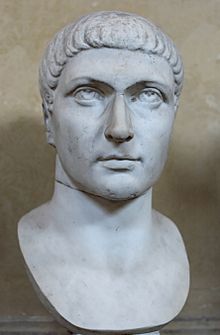Also known as:
Constantine The Great, Saint Constantine, Μέγας Κωνσταντίνος
More People of Greece
More Topic Categories
Constantine I (27/02/~272 - 22/05/337)
 Constantine I or Constantine the Great was a Roman Emperor.
Constantine I or Constantine the Great was a Roman Emperor.His real name was Flavius Valerius Constantinus and he was born in the city of Naissus, in modern Serbia, around 272 AD. His father, Constantius, was a Roman army officer, and his mother, Helena, was of low social standing. In his first years, Constantine was near his father, being educated according to military principles. In 293 AD, Emperor Diocletian appointed Constantius as Caesar of Gaul, Spain and Britain, but it was forbidden to high-rank officers to be married to women of humble origin. An edict was passed, divorcing Helena and Constantius, who married Theodora, a relative of co-emperor Maximian. Constantine and Helena were kept captives of Diocletian to ensure Constantius’ loyalty. There, Constantine received excellent education and he distinguished himself thanks to his appearance and physical beauty, his talents, his skills, his sense of duty and his grace, thus becoming favoured by Diocletian.
In 303 AD, Constantine witnessed the brutality of Diocletian’s Great Persecution, the most severe persecution of Christians throughout Roman times. In 305 AD, both Diocletian and Maximian retired and the two Caesars, Galerius and Constantius, were promoted to Augusti. Constantine remained hostage of Galerius, but skillfully, he managed to convince Galerius to send him to his father in the West.
In 306 AD, Constantius died and Constantine was declared Augustus, which infuriated Galerius and did not recognize him. After much scheming, he finally declared him Caesar. Constantine followed a tolerant policy towards Christianity, similarly to his father, probably judging that open persecution is not sensible, and that it was a way to distinguish himself from Galerius, the persecutor. Later in the same year, Maxentius, son of former Emperor Maximian, seized the title of emperor; Galerius did not recognize him and sent an army against him, but failed to seize him. Maximian offered his daughter’s hand to Constantine and elevation to Augustan rank, in exchange for support to Maxentius, which Constantine accepted. A period of turmoil followed, and in 310, Maximian, hungry for more power, rebelled against Constantine, who managed to capture him and force him to suicide.
In the years that followed, Constantine managed to crush all remaining opponents, and trying to integrate the East into the Roman Empire, he proposed to create a new Eastern capital that would become a centre of learning, prosperity and culture. This capital was the Greek city of Byzantium and was renamed Constantinopolis (Constantine’s city – Constantinople). In 313 AD, along with Augustus Licinius, Constantine realized that to achieve peace in the empire, a common religious policy should be followed; as a result, they signed the Edict of Milan, stating that all citizens are free to follow the religion of their choosing.
In the spring of 337, Constantine fell seriously ill and realized that he was dying. That’s when he asked to be baptized Christian and requested it right away. He died soon afterwards, on 22 May. As emperor, Constantine enacted many administrative, financial, social and military reforms. He realized that it was necessary to promote religious tolerance if the empire was to survive. Finally, he created a second capital in Byzantium, or Constantinople, managing to integrate the two parts of the Roman Empire into one.
See Also:
 Athens Photos
Athens Photos
 Santorini Photos
Santorini Photos
 Crete Photos
Crete Photos
 Meteora Photos
Meteora Photos
 Corfu Photos
Corfu Photos

